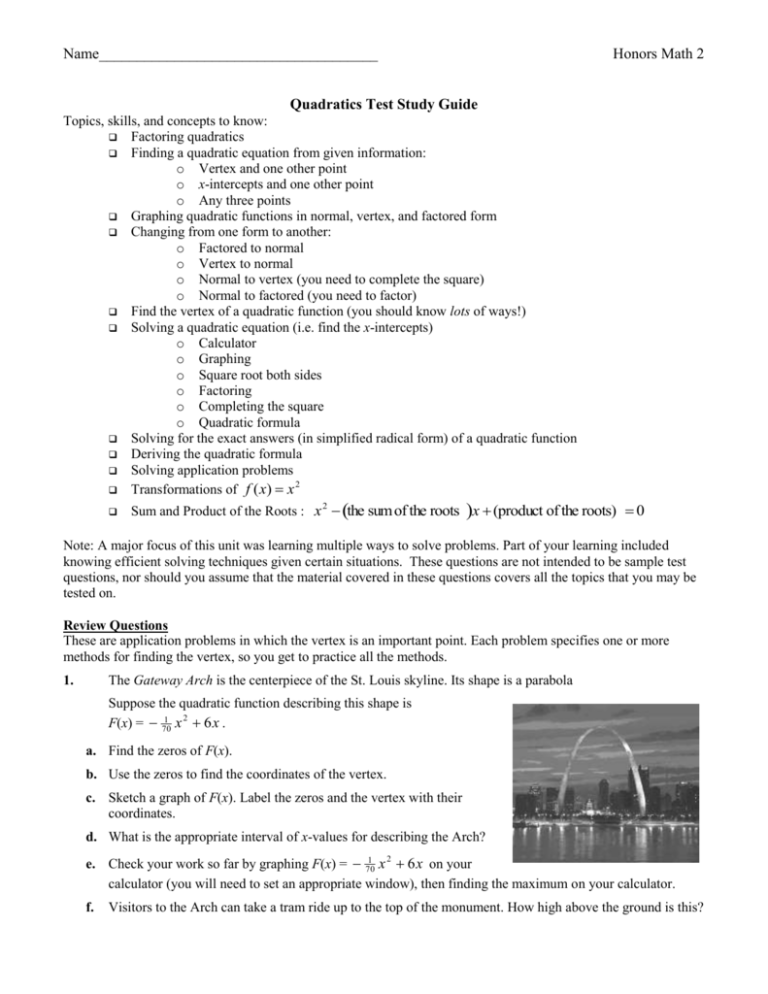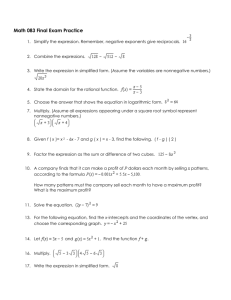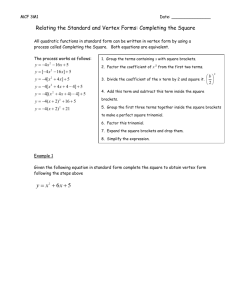Quadratics Test Study Guide
advertisement

Name_____________________________________ Honors Math 2 Quadratics Test Study Guide Topics, skills, and concepts to know: Factoring quadratics Finding a quadratic equation from given information: o Vertex and one other point o x-intercepts and one other point o Any three points Graphing quadratic functions in normal, vertex, and factored form Changing from one form to another: o Factored to normal o Vertex to normal o Normal to vertex (you need to complete the square) o Normal to factored (you need to factor) Find the vertex of a quadratic function (you should know lots of ways!) Solving a quadratic equation (i.e. find the x-intercepts) o Calculator o Graphing o Square root both sides o Factoring o Completing the square o Quadratic formula Solving for the exact answers (in simplified radical form) of a quadratic function Deriving the quadratic formula Solving application problems 2 Transformations of f ( x) x Sum and Product of the Roots : x 2 the sum of the roots x (product of the roots) 0 Note: A major focus of this unit was learning multiple ways to solve problems. Part of your learning included knowing efficient solving techniques given certain situations. These questions are not intended to be sample test questions, nor should you assume that the material covered in these questions covers all the topics that you may be tested on. Review Questions These are application problems in which the vertex is an important point. Each problem specifies one or more methods for finding the vertex, so you get to practice all the methods. 1. The Gateway Arch is the centerpiece of the St. Louis skyline. Its shape is a parabola Suppose the quadratic function describing this shape is 1 x 2 6x . F(x) = 70 a. Find the zeros of F(x). b. Use the zeros to find the coordinates of the vertex. c. Sketch a graph of F(x). Label the zeros and the vertex with their coordinates. d. What is the appropriate interval of x-values for describing the Arch? 1 x 2 6 x on your e. Check your work so far by graphing F(x) = 70 calculator (you will need to set an appropriate window), then finding the maximum on your calculator. f. Visitors to the Arch can take a tram ride up to the top of the monument. How high above the ground is this? 2. You are selling cookies for a school club at a bake sale. Naturally, the higher you set the selling price, the fewer cookies you will sell. Suppose that if the selling price is set at x cents, you will sell (500 – 4x) cookies. Let R(x) represent the total amount of money made from the cookie sale. The first four parts of this problem will ask you to use all four methods of finding the coordinates of the vertex. a. Write a function formula for R(x). b. Find the zeros of R(x), then use the zeros to find the coordinates of the vertex. c. Rewrite the formula for R(x) in the ax2 + bx + c form, then use the vertex. b 2a formula to find the coordinates of the d. Rewrite the formula for R(x) in vertex form, and use this to identify the vertex. e. On a graphing calculator, graph R(x) and find its vertex. f. You should have gotten the same x and y coordinates for the vertex from the first four parts of this problem. Do all your answers agree? g. What do the coordinates of the vertex tell you about the cookie sale? 3. a. Using completing the square, solve –2x2 + 4x + 6 = 0. b. Using completing the square, put y = –2x2 + 4x + 6 into vertex form and find the vertex. c. Compare the calculations used for parts a and b. What steps were the same? What steps were different? 4. Suppose that (x – k) is one of the factors of a quadratic function f(x). What else does this tell you about f(x) and its graph? What can you not discern from this information? Be specific. 5. Give an example of a quadratic whose zeros fit each description, or explain why you can’t. a. only one real zero b. two real zeros 6. Find a quadratic function whose zeros would be 1 2 c. three real zeros and –3, and has a y-intercept of 6. 2 7. Solve for x by completing the square: 0 2x kx m . 8. a. If you know the x-intercepts of a parabola, can you determine the vertex? Explain. b. If you know the x-intercepts of a parabola, can you determine the line of symmetry? Explain. 9. For a quadratic function y = ax2 + bx + c, under what circumstances would c represent both the y-intercept and the y-coordinate of the vertex? 10. Write an equation for a parabola that rises more steeply than y = x2 and has its vertex at (2, 5). 11. We studied three equation forms for quadratic functions: normal form, factored form, and vertex form. Using these three forms, write a set of three equations that all represent the same parabola. 2 12. Write a quadratic equation that has 2 distinct solutions that are: a. both integers b. both irrational 13. Solve by factoring: 14. a. 2x 2 7x 3 0 b. 5x 2 17x 6 c. 4 x 2 9 12x d. 7x 2 18x 11 0 e. 9x 2 30x 25 0 f. 4x 2 6x 9 4 0 Suppose the equation x 15x 40 0 has roots and . Without solving the equation, find a . quadratic equation with the following roots: 2 and 2 2 3 Answers 1. a. x 0, x 420 b. Vertex (210,630) d. 0 x 420 e. window 0 x 420 , 0 y 630 f. 630 feet 2. a. R( x) x(500 4 x) b-f. V(62.5,15625) g. 3. 4. 5. 6. At 62.5 cents, sell 250 cookies, and make $15,625 2x 2 4 x 6 0 y 2x 2 4 x 6 a. b. x 2 2x 3 0 y 2(x 2 2x 1 1) 6 y 2(x 1) 2 1 6 (x 1)2 4 0 y 2(x 1) 2 8 (x 1 2)(x 1 2) 0 x 1 , x 3 Vertex (1,8) (x k) If is a factor, then is an x-intercept of the graph (and a solution, zero, and root). You x k cannot discern if this is the only factor or if there is one other factor. You also don’t know the leading coefficient, a. Possible answers: 2 y (x 2) a. y (x 2)(x 3) b. c. Not possible. A quadratic has at most two real zeros. y a(x 12 )(x 3) 2x 2 kx m 0 7. x 2 k2 x m2 0 6 a(0 12 )(0 3) k2 k2 6 32 a x 2 k2 x 16 16 m2 0 2 2 a 4 8m x 2 4k k 16 0 1 y 4(x 2 )(x 3) 2 2 8m 8m y 4(x 2 52 x 32 ) x 4k k 16 x 4k k 16 0 2 y 4 x 10x 6 2 x k k4 8m a. Average the two x-intercepts to find the x-coordinate of the vertex. b. Average the two x-intercepts to find the line of symmetry. 0 When x b , so when b = 0. 2a Example: y 2(x 2) 2 5 Factored: y (x 2)(x 4) Normal: y x 2 6x 8 Vertex: y (x 3) 2 1 y (x 3)(x 4) , x 3,4 a. 2 y x 3, x 3 b. 1 x 2 ,3 a. 2 x ,3 b. 5 3 x c. 2 11 x d. 7 ,1 x 53 e. x 43 f. x 2 30x 160 0 4 8. 9. 10. 11. 12. 13. 14.









